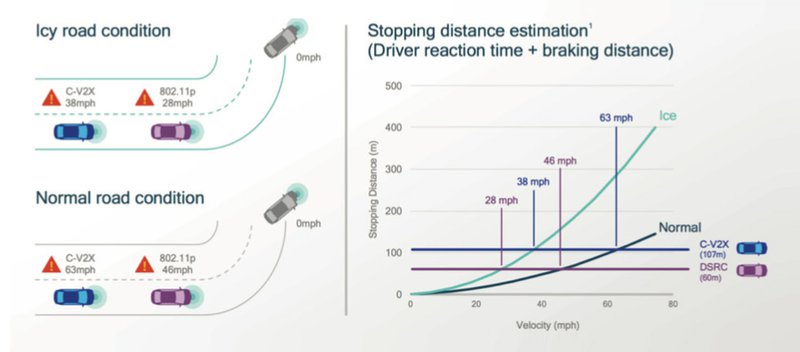
Imagine that you’re merging onto the highway and your vehicle suddenly takes care of the driving. The car accelerates to fit bumper-to-bumper with a group of vehicles traveling at a fast speed. You’re free to make the most of your commute without worrying about sudden congestion or other dangers of highway driving.
While this scenario may seem far-fetched, the reality is closer than many people imagine. Modern autonomous vehicles can already adjust their speed and pass other vehicles on highways. But the next-generation capabilities described in our example depend on real-time communication between vehicles.
In this article, we will take a closer look at how C-V2X technology enables this direct communication and seven examples of how it could transform the driving experience.
What is C-V2X Technology?
Cellular Vehicle-to-Everything, or C-V2X, technologies have the potential to transform safety and efficiency through cooperative intelligent transportation system. Using LTE and 5G technology, the technology provides a direct link of communication between vehicles and wider networks, reducing congestion and pollution while enhancing travel efficiency.
Automakers are already adding C-V2X connectivity into their vehicles with the introduction of Vehicle-to-Network infotainment systems. These capabilities will be expanded to include Vehicle-to-Vehicle, Vehicle-to-Infrastructure, and Vehicle-to-Pedestrian capabilities over time. Smart city technologies will be a key driver behind C-V2X adoption.
[content_upgrade cu_id=”3022″]Download our checklist for cities looking to support C-V2X in their infrastructure.[content_upgrade_button]Click Here[/content_upgrade_button][/content_upgrade]
Let’s take a look at some examples of how C-V2X technologies could reshape the way modern transportation works.
1. Platooning
Platooning, or flocking, involves dividing vehicles into groups that drive closer together than can be safely achieved with human drivers. These capabilities enable cars and trucks to accelerate and brake simultaneously, increasing the capacity of roads. The result is greater road capacity, less fuel use, and more efficient transportation of goods.
C-V2X can be used to enable communication between up to three vehicles in the platoon, as well as signal the presence of the platoon to other vehicles and roadside infrastructure. With low-latency 5G technology, platoons could include more than three vehicles with communication relays occurring throughout the lineup of cars and trucks.
2. Cooperative Driving
Cooperative driving involves minimizing disruptions caused by lane changes, sudden braking or other unexpected movements. Unlike platooning, cooperative driving seeks to minimize accidents due to sudden braking or other unexpected behavior on the part of other drivers — even if the behavior occurs outside of the driver or vehicle’s line of sight.
C-V2X technology will be instrumental in conveying intent to other road users. For example, when one vehicle overtakes another, the vehicle behind it could slow down automatically to make sufficient space to merge without disrupting traffic. The same processes could smooth a vehicle’s entry onto a highway.
3. Queue Warnings
Queue warnings alert drivers when there’s upcoming traffic congestion to avoid sudden braking and collisions. More than one-quarter of all traffic fatalities in work zones occur as a result of end of queue crashes. Queue warnings could be an inexpensive way to reduce that number by slowing drivers down before a queue appears in sight.
C-V2X could also enable roadside infrastructure to help vehicles retain a constant speed and reduce the number of so-called phantom traffic jams, which are caused by sudden braking and unexpected lane changes on highways.
4. Collision Avoidance
Many vehicles already have collision avoidance systems that detect vehicles or pedestrians, anticipate a collision, and automatically apply the brakes or take corrective steering actions. These technologies have proven to be very effective at reducing traffic fatalities, even in their basic form.
C-V2X technologies can make collision avoidance systems even more accurate by receiving inputs from nearby vehicles in realtime to better predict their actions. Each vehicle could broadcast its position, speed, direction and identity to other nearby vehicles to build a real-time map of their surroundings.
5. Hazard Warnings
Hazard warnings inform drivers about everything from vehicle crashes ahead to evolving weather conditions. By incorporating information from networks, vehicles, and infrastructure, these warnings can be much more localized and accurate. A car that spun out on black ice could alert other nearby vehicles of the road hazard and help them avoid making the same mistake.

6. Autonomous Driving
Autonomous vehicles are already starting to hit the streets. For example, Tesla’s summon function enables a person to summon their car from a parking spot to pick them up. While modern AVs rely on a wide range of sensors, C-V2X technology could improve their capabilities by alerting vehicles of nearby driver intent or hazards outside of the line of sight.
[content_upgrade cu_id=”3022″]Don’t forget to download our checklist for cities looking to support C-V2X in their infrastructure.[content_upgrade_button]Click Here[/content_upgrade_button][/content_upgrade]
7. Road Tolls
Toll roads can lead to significant queues in places like Illinois, while automated tolls still rely on mailing bills and honest drivers, in the case of HOV lanes. C-V2X could automate the billing process for toll lanes and automatically communicate HOV status and other information. These efforts could increase revenue and reduce traffic congestion for cities and states.
The Bottom Line
C-V2X technologies are quickly transforming transportation and many of the benefits may arrive sooner than expected. In addition to the benefits to vehicles, C-V2X technology could provide valuable data to cities and states when it comes to traffic patterns, congestion, and other issues. This data could be used to help re-shape policies and improve transportation.
Applied Information provides C-V2X infrastructure solutions to cities and states interested in adding Vehicle-to-Infrastructure capabilities without the cost of replacing all of their equipment. By adding cellular functionality to existing infrastructure, cities can realize the benefits of C-V2X and prepare for the future at a much lower cost.
In addition to C-V2X connectivity, we provide a wide range of smart city solutions that can help dramatically improve traffic flow, emergency response times, school zone speed compliance, pedestrian crosswalks and other key issues facing cities.
